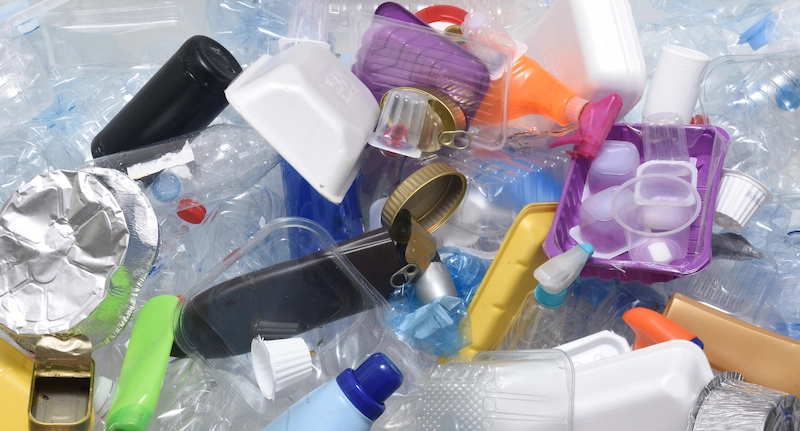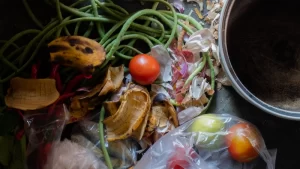Table of Contents
Do you know that inorganic waste comes from human and industrial activities? Inorganic waste is a common thing you can find everywhere, whether in households, offices, or hospitals.
Based on data collected by the Sistem Informasi Pengelolaan Sampah Nasional (SIPSN) in 2023, as much as 38.38% or around 14 million more tons of organic and inorganic waste were unmanaged.
The existing issue of wastage should urge the younger generation to care about the environment and start understanding the importance of proper waste management. As a starter, let’s learn about the examples of inorganic waste and its management benefits below!
What Is Inorganic Waste?
Inorganic waste is non-biodegradable waste that is difficult to decompose naturally by microorganisms. This waste consists of materials that take a long time to decompose.
Unlike organic waste that can be turned into compost, inorganic waste doesn’t have the materials needed by nature. As a result, piles of unmanaged inorganic waste can pollute soil, water, and air if not properly disposed of or managed.
Therefore, managing inorganic waste requires special efforts. One way to do it is to recycle it into new products. In this way, we can reduce the amount of inorganic waste in landfills and help protect the environment.
Types of Inorganic Waste
Inorganic waste is divided into two main types: soft inorganic waste and hard inorganic waste. Both have different characteristics. Here’s how to differentiate them:
1. Soft Inorganic Waste
Soft inorganic waste has a relatively flexible structure but is not too hard. Some examples include styrofoam and paper. In addition, this type of waste can also take the form of liquid, such as detergent, used cooking oil, and so on.
Soft inorganic waste management tends to be simple. This waste can be recycled into various new products, such as packaging, bags, or materials for making clothing.
Read also: 3 Ways to Turn Clothes Waste into Useful!
2. Hard Inorganic Waste
Hard inorganic waste, such as metal, glass, and electronic waste, has a strong structure. That’s why specific technology is required to recycle this type of waste. However, hard inorganic waste can be recycled as raw materials for various industrial needs.
Inorganic Waste Examples
After understanding the types, here are examples of inorganic waste that you might often encounter in your daily life:
1. Plastic
Plastic is one example of inorganic waste most commonly found in every sector of life. Whether you realize it or not, items such as drinking bottles, food containers, and automotive tools are generally made of plastic.
Plastic waste can be recycled into something valuable and useful, as done by Chandra Asri Group.
We aim to improve community welfare by implementing a circular economy by processing plastic waste into plastic asphalt and vehicle fuel. Interesting, right?
Chandra Asri Group through Indonesia Asri also continues to promote education related to waste sorting and management to the community in the hope that plastic waste utilization can be more optimal.
2. Metals
Metal is also included in the category of hard inorganic waste that is difficult to decompose. Some metal waste often found in everyday life comprises beverage cans, used household appliances, and scrap metal.
3. Paper
Paper waste includes old newspapers, magazines, and cardboard boxes. It can be recycled into new paper or other products, such as cartons and valuable handicrafts.
Crafty hands can even turn it into valuable artwork. Recycling paper can help reduce the cutting of trees needed for new paper.
4. Glass
Another example of hard inorganic waste often found in everyday life is glass. This waste does not decompose easily. Common examples are glass bottles, broken windows, or used glasses.
5. Electronic Waste (E-Waste)
E-waste includes broken or unused electronic items, such as cell phones, computers, and batteries. This waste contains hazardous chemicals that require specific handling to ensure it does not pollute the environment.
For example, the government-initiated E-Waste Pickup started in 2017 in Jakarta. This initiative helps store e-waste in special hazardous waste containers according to its specifications.
Read also: The Importance of Digital Decluttering: Why You Should Do It Regularly!
Benefits of Inorganic Waste
Properly managed inorganic waste may offer environmental benefits and improve the quality of life. Here are some of the benefits of inorganic waste management:
1. Biogas
One of the benefits of inorganic waste is the production of biogas, an environmentally friendly alternative energy source. Some types of plastic can be mixed with organic waste and processed into methane gas that can be used as fuel. In addition to minimizing the amount of waste in landfills, biogas production from inorganic waste can also help reduce dependence on fossil fuels.
2. Handicrafts

Inorganic waste, such as plastic and paper, can be used as basic handicraft materials. Several common handicrafts made from inorganic waste are flower vases from plastic bottles, pencil cases from cans, and decorative ornaments from glass. These crafts not only help reduce waste but also produce economically valuable products.
3. Industrial Raw Materials
Some inorganic waste, such as metal and glass, can be recycled into industrial raw materials. For example, scrap metal can be reused to manufacture vehicles or household appliances. By using inorganic waste as raw material, industries can save production costs while preserving nature.
4. Plastic Asphalt

Did you know that inorganic waste, especially plastic, can be processed into useful plastic asphalt? As mentioned above, Chandra Asri Group has successfully converted plastic waste into quality asphalt products.
As a result, plastic asphalt can improve road stability by up to 40%. This type of asphalt has even been used for more than 120 km throughout Indonesia.
That’s all about inorganic waste, its types, examples, and management benefits. Understanding the examples of inorganic waste can urge us to care more about the environment.
To manage inorganic waste, you can start with small things, such as separating inorganic and organic waste at home and then depositing it in the waste bank according to its type. Alternatively, you can recycle unused items. In addition, you can also join the Operasi Semut movement by Indonesia Asri.
This movement aims to educate the public about the importance of sorting waste. Managing waste based on its type can help with the recycling process. So, let’s register now and show that the younger generation can be agents of change for a greener future!
Read also: What Is Circular Economy? Here’s How Circular Economy Actions Benefit Our Environment










